TOYOTA LAND CRUISER 2008 J200 Owners Manual
Manufacturer: TOYOTA, Model Year: 2008, Model line: LAND CRUISER, Model: TOYOTA LAND CRUISER 2008 J200Pages: 531, PDF Size: 5.6 MB
Page 231 of 531

233
2−5. Driving information
2
When driving
Trailer towing tips
Your vehicle will handle differently when towing a trailer. The 3 main
causes of vehicle−trailer accidents
are driver error, excessive speed
and improper trailer loading. Keep the following in mind when towing.
l
Before starting out, check the trailer lights and the vehicle−trailer
connections. Recheck after driving a short distance.
lPractice turning, stopping and reve rsing with the trailer attached in
an area away from traffic until you become accustomed to the feel
of the vehicle.
l
Reversing with a trailer attached is difficult and requires practice.
Grip the bottom of the steering wheel and move your hand to the
left to move the trailer to the left. Move your hand to the right to
move the trailer to right. (This
is generally opposite to reversing
without a trailer attached.) Avoid sharp or prolonged turning. Have
someone guide you when reversing to reduce the risk of an acci−
dent.
lAs stopping distance is increased when towing a trailer, vehicle−to
vehicle distance should be increased. For each 10 mph (16 km/h)
of speed, allow at least o
ne vehicle and trailer length.
lAvoid sudden braking as you may skid, resulting in jackknifing and
loss of control. This is especiall
y true on wet or slippery surfaces.
lAvoid jerky starts or sudden acceleration.
l
Avoid jerky steering and sharp turns, and slow down before mak−
ing turns.
Page 232 of 531

234 2−5. Driving information
lNote that when making a turn, the trailer wheels will be closer than
the vehicle wheels to the inside of the turn. Compensate by making
a larger than normal turning radius.
lCrosswinds and rough roads will adversely affect handling of your
vehicle and trailer, causing sway
. Periodically check the rear to
prepare for being passed by large trucks or buses, which may
cause your vehicle and trailer to sway. If swaying occurs, firmly grip
the steering wheel, reduce speed immediately but gradually, and
steer straight ahead. Never increase speed. If you make no
extreme correction with the stee ring or brakes, your vehicle and
trailer will stabilize.
lTake care when passing other vehicles. Passing requires consider−
able distance. After passing a vehi
cle, do not forget the length of
your trailer, and be sure you hav e plenty of room before changing
lanes.
lIn order to maintain engine braking efficiency when driving on a
long steep downgrade, do not use overdrive. Transmission shift
range position must be in “4”, in “S” mode.
lDue to the added load of the trailer, your vehicle’s engine may
overheat on hot days (at temperatur
es over 85°F [30°C] when driv−
ing up a long or steep grade. If the engine coolant temperature
gauge indicates overheating, immediately turn off the air condition−
ing (if in use), pull your vehicle off
the road and stop in a safe spot.
( P. 488)
Page 233 of 531

235
2−5. Driving information
2
When driving
lAlways place wheel blocks under both the vehicle and the trailer
wheels when parking. Apply the parking brake firmly, and put the
transmission in “P”. Avoid parking on a slope, but if unavoidable,
do so only after performing the following:
Apply the brakes and keep them applied.
Have someone place wheel bloc
ks under both the vehicle and
trailer wheels.
When the wheel blocks are in pl
ace, release the brakes slowly
until the blocks absorb the load.
Apply the parking brake firmly.
Shift into “P” and turn off the engine.
lWhen restarting after parking on a slope:
With the transmission in the “P ” position, start the engine. Be
sure to keep the brake pedal pressed.
Shift into “3”, “2”, “1”, or “R” position (if reversing).
Release the parking brake and
brake pedal, and slowly pull or
back away from the wheel blocks. Stop and apply the brakes.
Have someone retrieve the blocks.
STEP1
STEP 2
STEP 3
STEP 4
STEP 5
STEP 1
STEP 2
STEP 3
STEP 4
Page 234 of 531

236 2−5. Driving information
nBefore towing
Check that the following conditions are met:
lThe vehicle’s tires are properly inflated.
lTrailer tires are inflated according to the trailer manufacturer ’s recom−
mendation.
lAll trailer lights work.
lAll lights work each time you connect them.
lThe trailer ball is set up at the proper height for the coupler on the trailer.
lThe vehicle remains level when a loaded or unloaded trailer is hitched.
Do not drive if the vehicle is not level, and check for improper tongue
load, overloading, worn suspension, or other possible causes.
lThe trailer cargo is securely loaded.
lThe rear view mirrors conform to all applicable federal, state/provincial or
local regulations. If they do not, install rear view mirrors appropriate for
towing purposes.
nBreak�in schedule
Toyota recommends that you do not use a new vehicle or a vehicle with any
new power train components (engine, transmission, differential, wheel bear−
ings, etc.) to tow a trailer for the first 500 miles (800 km) of driving.
nMaintenance
lIf you tow a trailer, your vehicle will require more frequent maintenance
due to the additional load. (See “Scheduled Maintenance Guide” or
“Owner ’s Manual Supplement”.)
lRetighten the fixing bolts of the towing ball after approximately 600 miles
(1000 km) of trailer towing.
Page 235 of 531
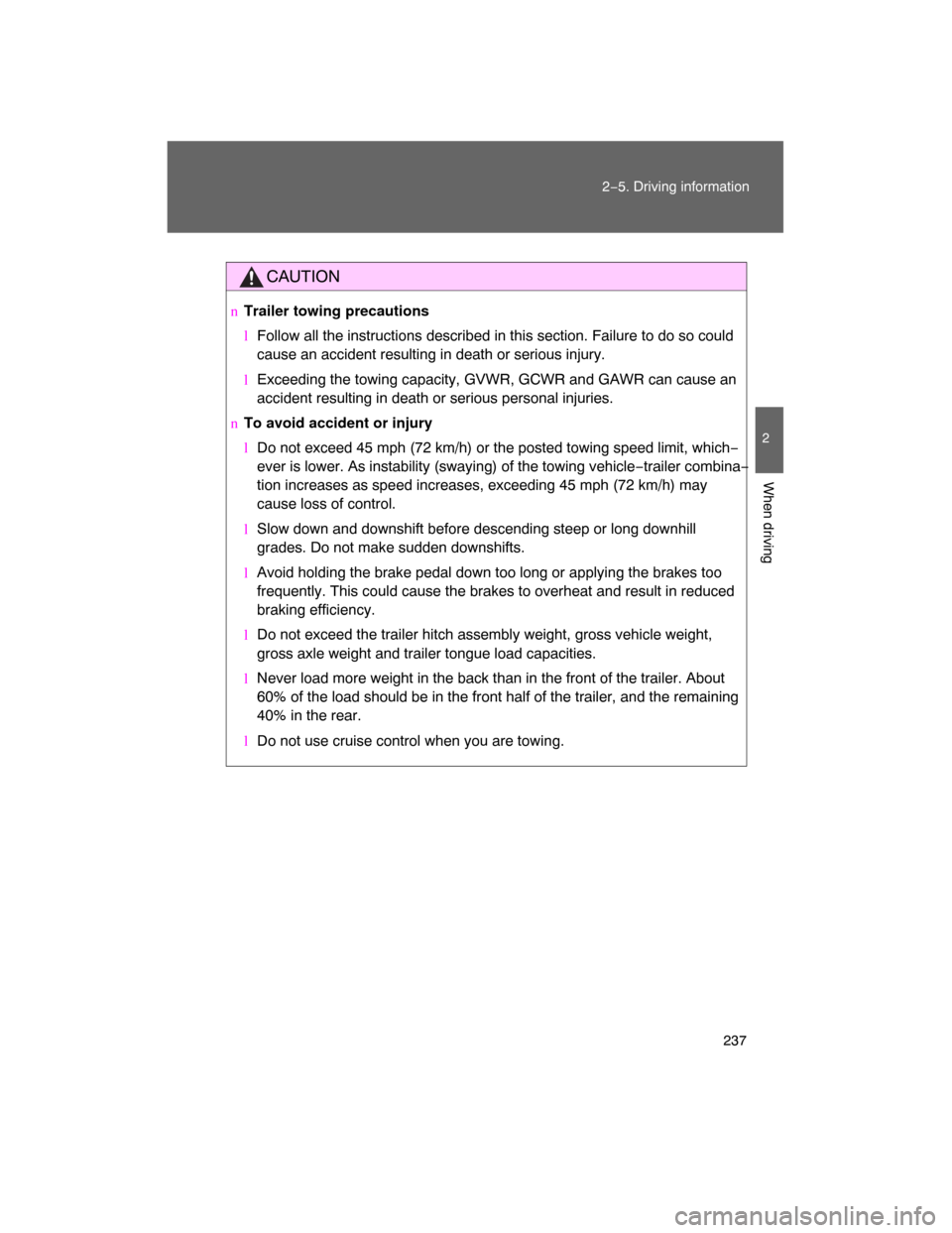
237
2−5. Driving information
2
When driving
CAUTION
nTrailer towing precautions
lFollow all the instructions described in this section. Failure to do so could
cause an accident resulting in death or serious injury.
lExceeding the towing capacity, GVWR, GCWR and GAWR can cause an
accident resulting in death or serious personal injuries.
nTo avoid accident or injury
lDo not exceed 45 mph (72 km/h) or the posted towing speed limit, which−
ever is lower. As instability (swaying) of the towing vehicle−trailer combina−
tion increases as speed increases, exceeding 45 mph (72 km/h) may
cause loss of control.
lSlow down and downshift before descending steep or long downhill
grades. Do not make sudden downshifts.
lAvoid holding the brake pedal down too long or applying the brakes too
frequently. This could cause the brakes to overheat and result in reduced
braking efficiency.
lDo not exceed the trailer hitch assembly weight, gross vehicle weight,
gross axle weight and trailer tongue load capacities.
lNever load more weight in the back than in the front of the trailer. About
60% of the load should be in the front half of the trailer, and the remaining
40% in the rear.
l
Do not use cruise control when you are towing.
Page 236 of 531
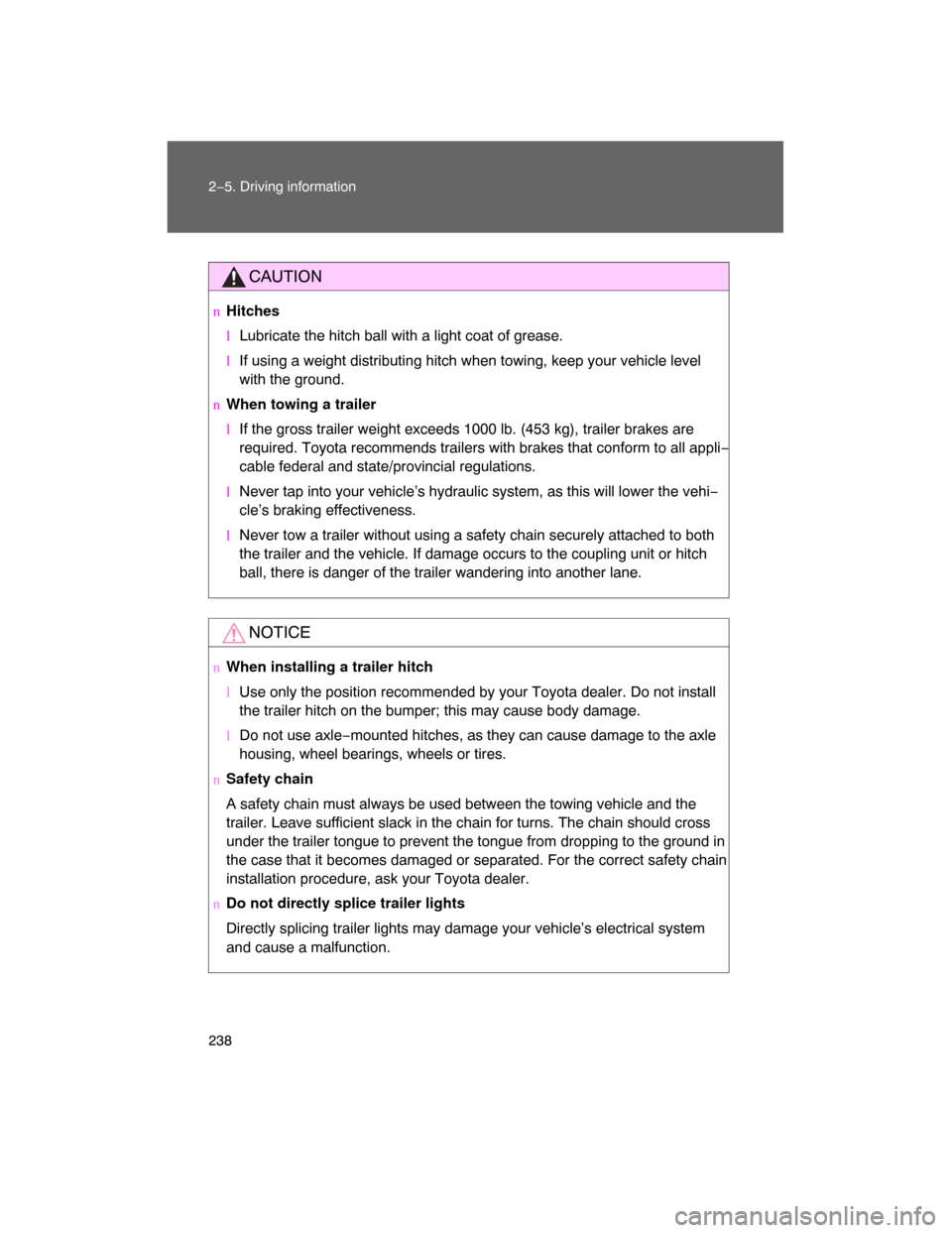
238 2−5. Driving information
CAUTION
nHitches
lLubricate the hitch ball with a light coat of grease.
lIf using a weight distributing hitch when towing, keep your vehicle level
with the ground.
nWhen towing a trailer
lIf the gross trailer weight exceeds 1000 lb. (453 kg), trailer brakes are
required. Toyota recommends trailers with brakes that conform to all appli−
cable federal and state/provincial regulations.
lNever tap into your vehicle’s hydraulic system, as this will lower the vehi−
cle’s braking effectiveness.
lNever tow a trailer without using a safety chain securely attached to both
the trailer and the vehicle. If damage occurs to the coupling unit or hitch
ball, there is danger of the trailer wandering into another lane.
NOTICE
nWhen installing a trailer hitch
lUse only the position recommended by your Toyota dealer. Do not install
the trailer hitch on the bumper; this may cause body damage.
lDo not use axle−mounted hitches, as they can cause damage to the axle
housing, wheel bearings, wheels or tires.
nSafety chain
A safety chain must always be used between the towing vehicle and the
trailer. Leave sufficient slack in the chain for turns. The chain should cross
under the trailer tongue to prevent the tongue from dropping to the ground in
the case that it becomes damaged or separated. For the correct safety chain
installation procedure, ask your Toyota dealer.
nDo not directly splice trailer lights
Directly splicing trailer lights may damage your vehicle’s electrical system
and cause a malfunction.
Page 237 of 531
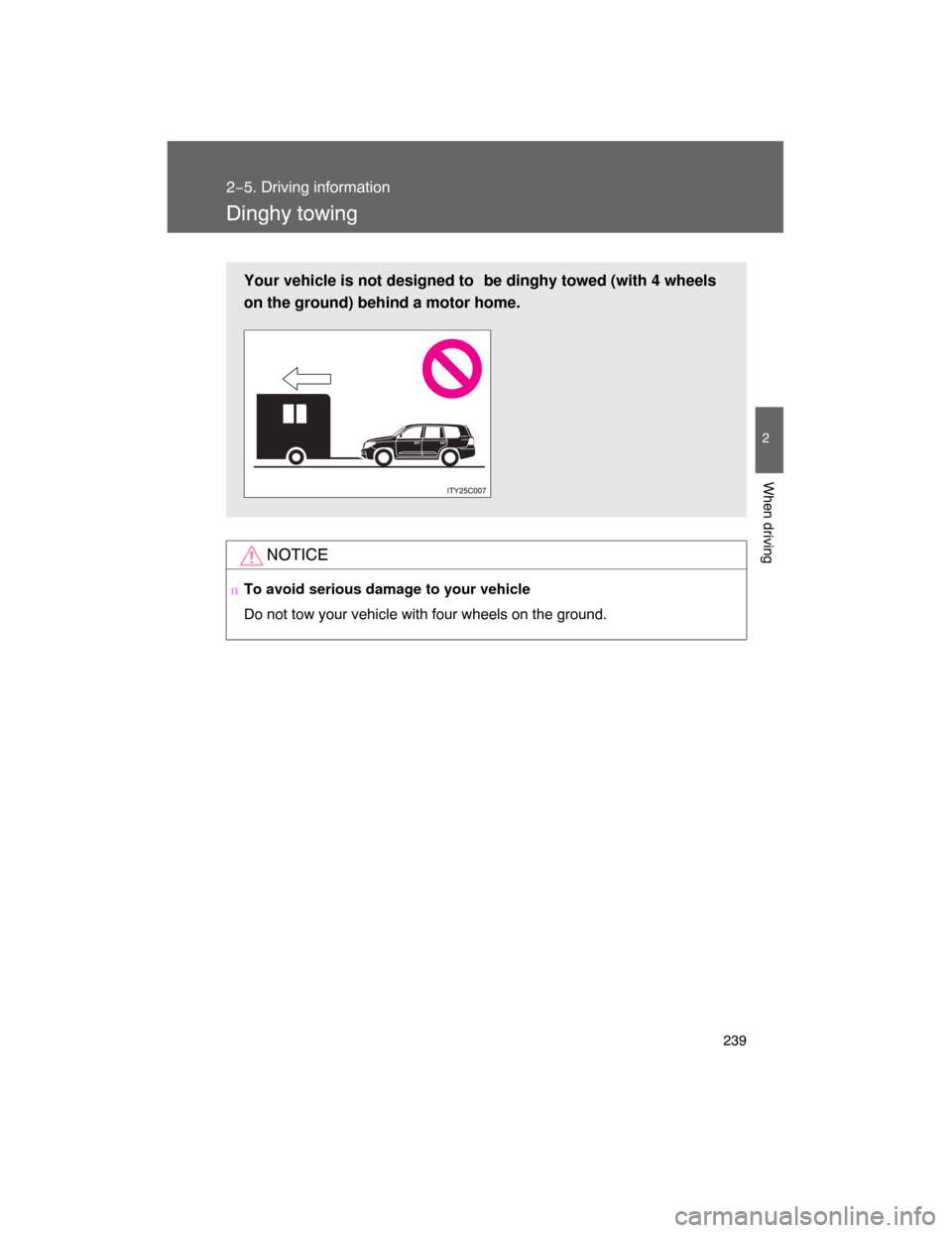
239
2−5. Driving information
2
When driving
Dinghy towing
NOTICE
nTo avoid serious damage to your vehicle
Do not tow your vehicle with four wheels on the ground.
Your vehicle is not designed to be dinghy towed (with 4 wheels
on the ground) behind a motor home.
Page 238 of 531
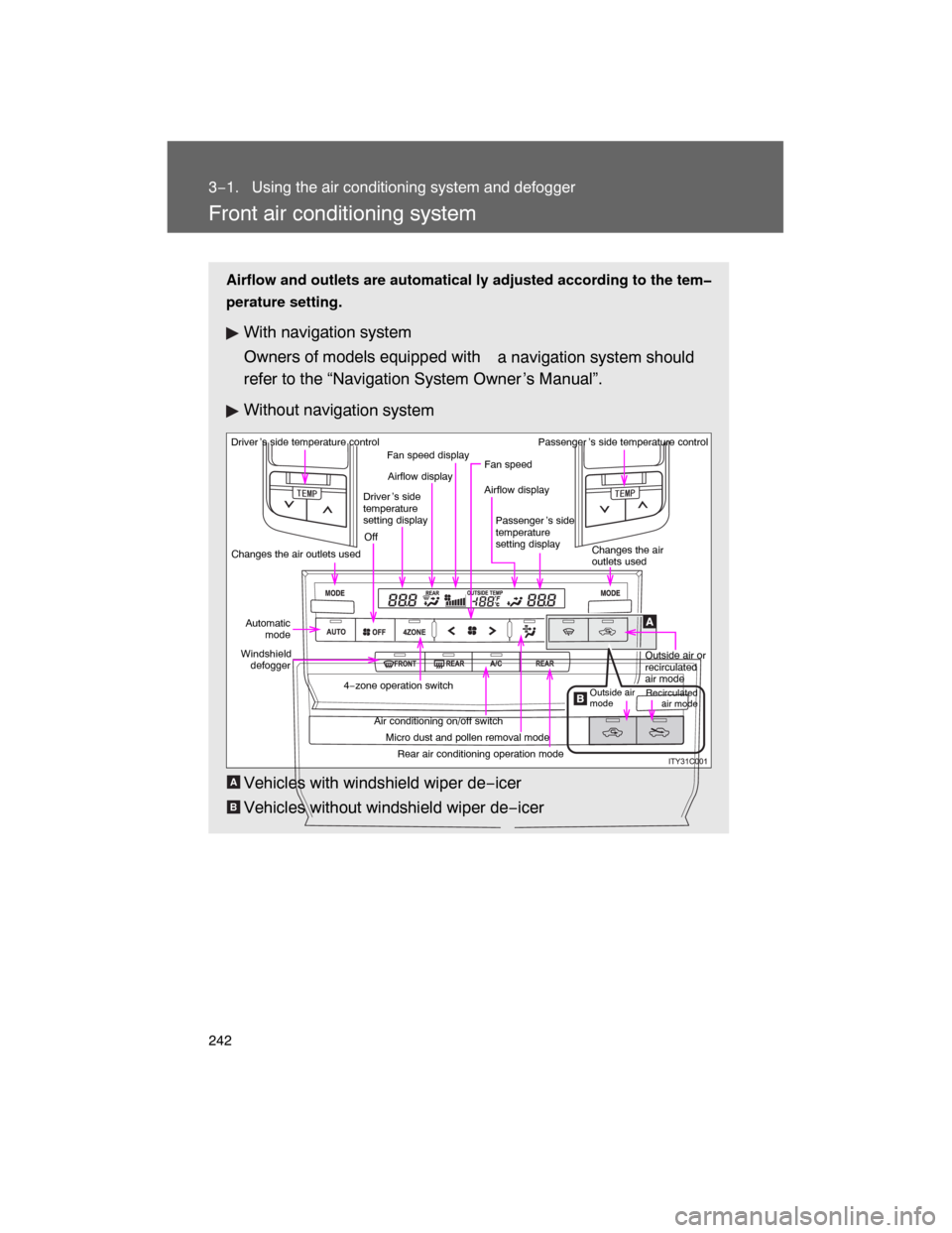
242
3−1. Using the air conditioning system and defogger
Front air conditioning system
Airflow and outlets are automatical ly adjusted according to the tem�
perature setting.
With navigation system
Owners of models equipped with
a navigation system should
refer to the “Navigation System Owner ’s Manual”.
Without navig
ation system
Vehicles with windshield wiper de−icer
Vehicles without windshield wiper de−icer
Driver ’s side temperature control
Changes the air outlets usedOff Driver ’s side
temperature
setting displayAirflow display Fan speed display
Fan speed
Airflow display
Passenger ’s side
temperature
setting displayPassenger ’s side temperature control
Changes the air
outlets used
Outside air or
recirculated
air mode
Outside air
modeRecirculated
air mode
Rear air conditioning operation mode Micro dust and pollen removal mode Air conditioning on/off switch 4−zone operation switch Windshield
defogger Automatic
mode
A
B
Page 239 of 531
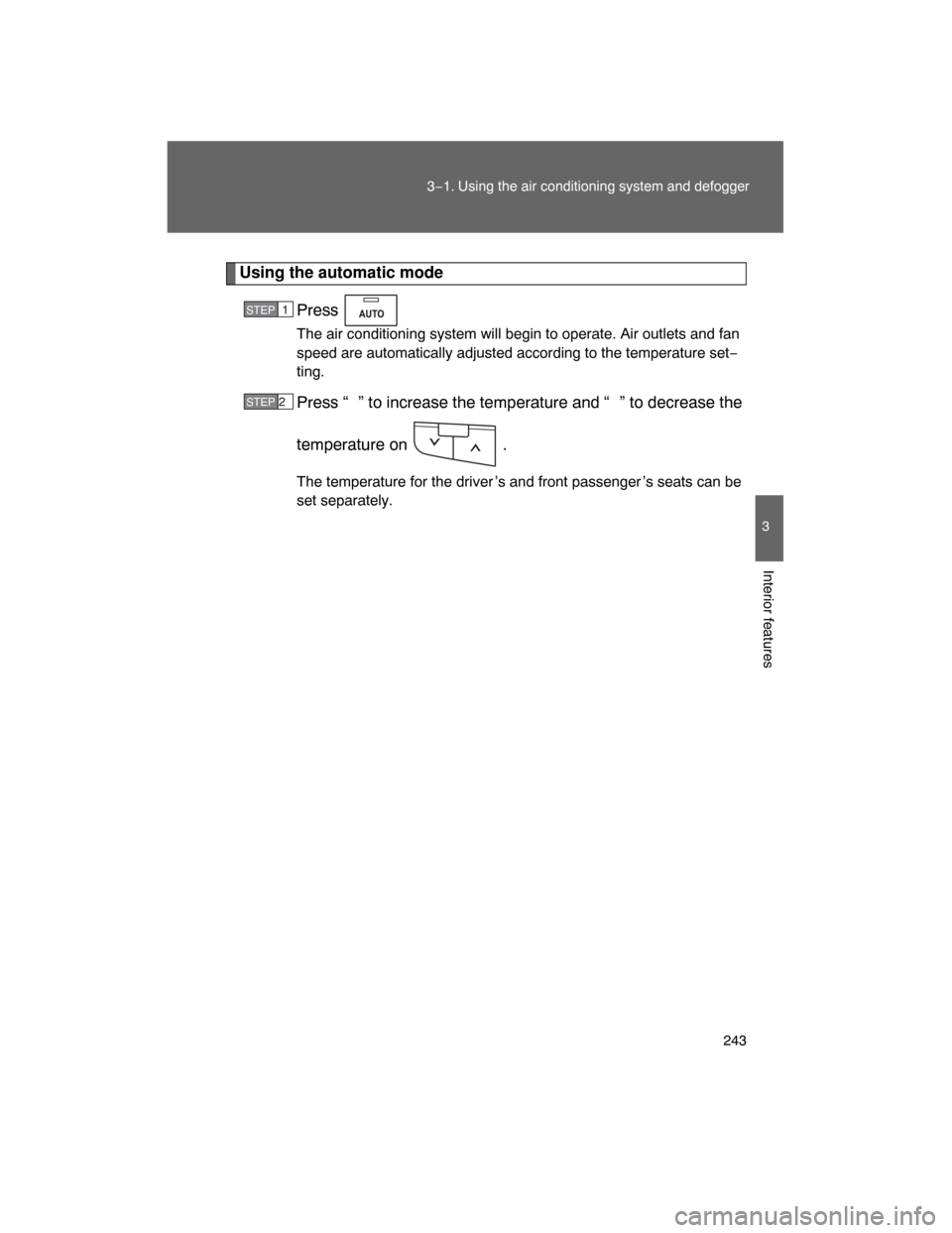
243
3−1. Using the air conditioning system and defogger
3
Interior features
Using the automatic mode
Press .
The air conditioning system will begin to operate. Air outlets and fan
speed are automatically adjusted according to the temperature set−
ting.
Press “ ” to increase the temperature and “ ” to decrease the
temperature on .
The temperature for the driver ’s and front passenger ’s seats can be
set separately.
STEP1
STEP 2
Page 240 of 531
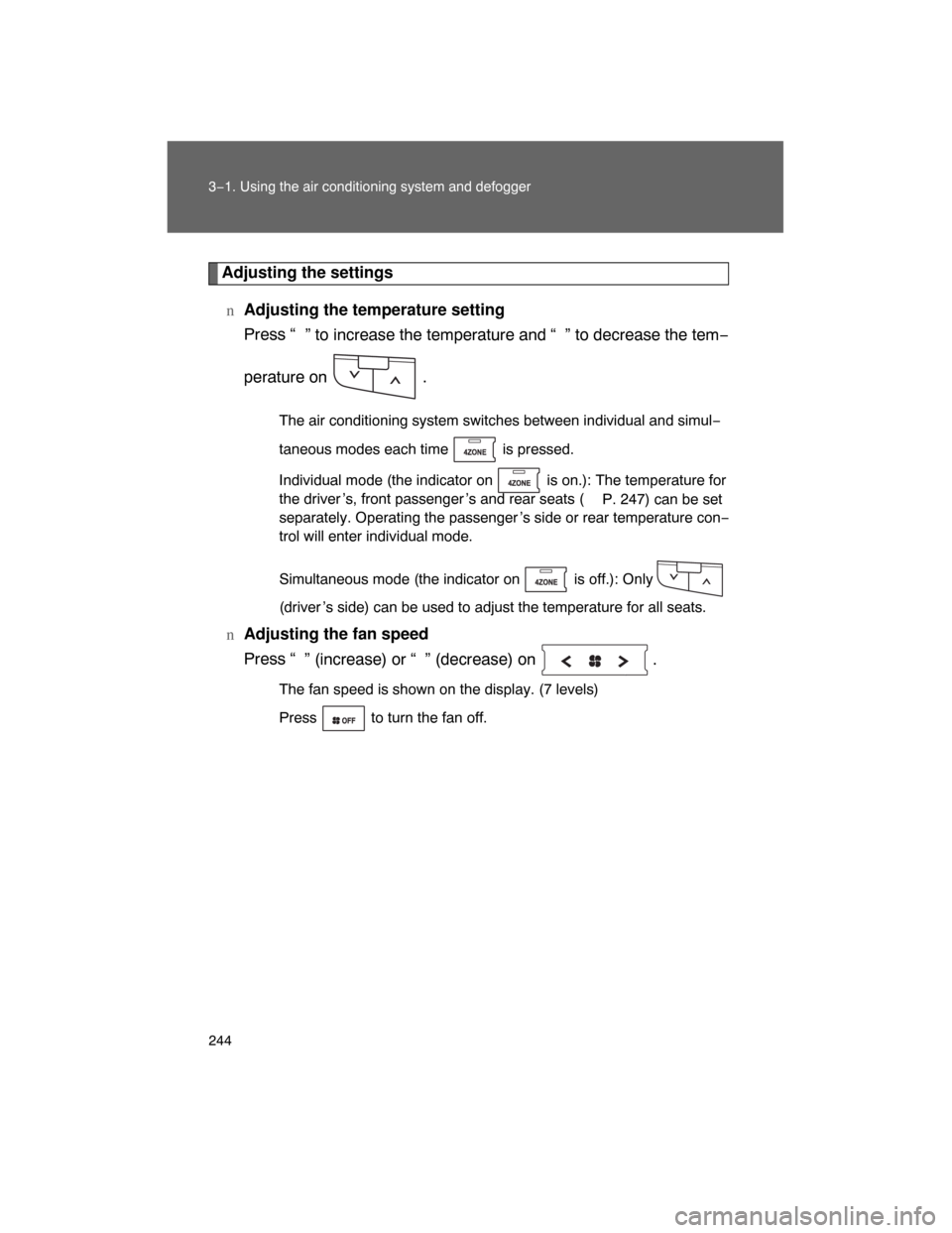
244 3−1. Using the air conditioning system and defogger
Adjusting the settings
nAdjusting the temperature setting
Press “
” to increase the temperature and “ ” to decrease the tem−
perature on .
The air conditioning system switches between individual and simul−
taneous modes each time is pressed.
Individual mode (the indicator on is on.): The temperature for
the driver ’s, front passenger ’s and rear seats (
P. 247) can be set
separately. Operating the passenger ’s side or rear temperature con−
trol will enter individual mode.
Simultaneous mode (the indicator on is off.): Only
(driver ’s side) can be used to adjust the temperature for all seats.
nAdjusting the fan speed
Press “
” (increase) or “ ” (decrease) on .
The fan speed is shown on the display. (7 levels)
Press to turn the fan off.